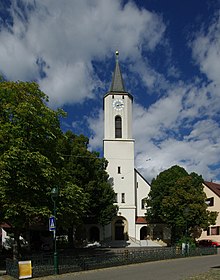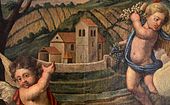St. Urban (Freiburg im Breisgau)
St. Urban is the Catholic parish church in the Herdern district of the city of Freiburg im Breisgau . The current building dates from 1935/36. It is named after the canonized Pope Urban I , who is considered the patron saint of winemakers.
history
The village of Herdern was mentioned for the first time in 1008, the church itself has only been documented since 1239. The proof is the pledge of the patronage right over the Herdern Church to the Bishop of Strasbourg . The pastor's office has existed since the early Middle Ages and was financed from the tithing of the local population. The Bishop of Constance Heinrich von Hewen transferred the church to the Teutonic Order House in Freiburg in 1142 , which was then responsible for pastors, worship and maintenance. Even after the purchase of Herdern by Freiburg in 1457, the church remained with the Teutonic Order House with all rights and obligations. This dichotomy led to disputes between the citizens and the Teutonic Order, which only carelessly performed its duties, so that the church fell into disrepair.
The hallmark of this old Romanesque church was the small, massive tower with a gable roof , to which a nave was attached. The village cemetery was laid out directly around the church and was surrounded by a wall. The citizens of Herdern were buried here until 1839. A picture of the first church can be seen on the altarpiece by Johann Caspar Brenzinger “Saint Urban in front of the church”.
In 1839 the dilapidated church was demolished and a new building was built on the same site. The pastor Protas Schanno, who has been active there since 1837 and who laid the foundation stone on October 21, played a key role ; this is also walled in in the current building. In 1841 the church was finished and was consecrated on October 18th by the future Archbishop of Freiburg Hermann von Vicari . The new bells were installed in 1843 and from 1845 there was also the tower clock. The new building as a three-aisled building doubled the space for the faithful. The church tower was also adapted to the new size and twice as high. The church equipment was only acquired and completed over the next few years. Thus Fritz Geiges , a famous Freiburger glass painter , stained glass windows designed for lateral movements; some of these can still be seen today.
As Freiburg and Herdern grew together, the population grew and the church again became too small. A church building association was founded in 1911, which had already collected the funds for the new building in 1914. Due to the First World War and its aftermath, the saved sums were quickly worthless, but were sufficient to purchase the building site. It took until the end of April 1935 for the church building to be demolished after a farewell service. The tower remained standing in order to preserve the townscape and the foundations of the old nave continued to be used. A church heating system was installed, the installation and operating costs of which were borne by the Baden tax authorities at 60% according to the Bonndorf comparison . The church was consecrated on October 18, 1936 by Archbishop Conrad Gröber . The bells and the tower clock were given to the Holy Family parish church in Betzenhausen. Until 2002, the interior of the church was redesigned several times. The last major renovation took place in 2003.
To the current church
The new building was created according to the concept of the architect Hans Herkommer , but due to the lack of space and the desired number of spaces, the aisles had to be limited to the choir and galleries had to be built. The side altars were attached to transverse walls in the choir aisles.
The painting of the choir, the baptistery and the back walls of the side altars were created by Georg Scholz (1890–1945) and his student Manfred A. Schmid (1911–2009). The beam ceiling and the necessary tension beams were designed in color. The first two nave windows and the rosary windows, which were created from the glass of the previous church, are reminiscent of the previous church. Franz Spiegelhalter created the pulpit with the pictures of the church fathers.
A group of figures by the artist Emil Sutor was planned for the outer facade, but was not installed on the instructions of the city. The model of this crucifixion group with Mary and John was placed opposite the pulpit.
During the last renovation, the choir was redesigned by Hubert Kaltenmark from Kressbronn and the windows by Dieter F. Domes from Langenargen. At the same time, the galleries and the rear walls of the side altar were removed, thus realizing the original concept of the Herkommer churches.
The altarpiece from the medieval church by Johann Caspar Brenzinger , which depicts St. Urban in front of the church, found its place in the new church, as did the two panel paintings by Wilhelm Dürr , St. Josef with Jesusknaben to the right of the entrance and Bernhard von Baden to the left of the entrance.
In the newly created altar, the ambo was cut from the altar stone , and in the baptismal font , the Easter candlestick was created from the removed interior of the stone .
organ
The organ goes back to a two-manual instrument made by the organ building company Späth (Ennetach) in 1924. In 1936 it was expanded to 51 stops (including extensions), three manuals and a pedal . The performance and register actions are electro-pneumatic .
|
|
|
|
|
|||||||||||||||||||||||||||||||||||||||||||||||||||||||||||||||||||||||||||||||||||||||||||||||||||||||||||||||||||||||||||||||||||||||||||||||||||||||||||||||||||||||||||||||||||||||||||||||||||||||||||||||||||||||||||||||||||||||||
-
Pairing :
- Normal coupling: II / I, III / I, III / II, I / P, II / P, III / P
- Sub-octave coupling: III / I
- Super octave coupling: II / I, III / I, II / P
- Playing aids : free combinations, piano pedal (II, III), stop and stop (pipe works, bomb works, 16 'registers, single reeds), tutti, crescendo roller, swell kicks
Bells
In 1954, St. Urban received a new six-part bronze bell from the bell foundry of Friedrich Wilhelm Schilling from Heidelberg. In 1964 the ringing was supplemented by a seventh bell from the same foundry, the smallest.
| No. | Weight kg | Ø (mm) | Chime |
|---|---|---|---|
| 1 | 2480 | 1520 | cis'-3 |
| 2 | 1365 | 1262 | e'-3 |
| 3 | 1035 | 1140 | f sharp'-3 |
| 4th | 581 | 948 | a'-3 |
| 5 | 400 | 837 | h'-3 |
| 6th | 289 | 747 | cis '' - 4 |
| 7th | 267 | 713 | e '' - 4 |
Patronage
The Urbans patronage indicates that Herdern's main income was generated by the local winegrowers . Today the St. Urbans Festival is an integral part of local life. It takes place on the Sunday after May 25th, the feast day of the saint. The statue of St. Urban, decorated with grapes from the last harvest - which a local winemaker specially preserved for it - was carried in a procession through the place decorated with flowers and white and yellow flags. Today fresh grapes are used for this.
literature
- Eugen Baumgartner : Parish church and parish St. Urban zu Freiburg-Herdern in their historical and legal development . In: Freiburg Diocesan Archive NF 37 = 64, 1936, pp. 134–208; NF 38 = 65, 1937, pp. 78-124 ( digitized part 1 , part 2 ).
Individual evidence
- ↑ Flyer of the Herdemer Höhenweg. Editor of the Bürgererverein Herdern e. V.
- ↑ Eugen Baumgartner : Parish Church and Parish St. Urban zu Freiburg-Herdern in: Freiburg Diocesan Archive , Volume 65, 1937, p. 102 ( digitized version ).
- ↑ Hans Sigmund: A life for painting. Badische Zeitung of August 4, 2009. Accessed July 1, 2013.
- ↑ Ulrike Laule, Konrad Hauser: Four pictures by the court painter Wilhelm Dürr in St. Urban in Freiburg-Herdern . In: Freiburger Diözesan-Archiv Vol. 125, 2005, pp. 379–383 ( digitized version ).
- ↑ More information about the Späth organ ( memento from August 2, 2012 in the web archive archive.today )
- ^ Bell inspection of the Archdiocese of Freiburg - Catholic parish church of St. Urban in Freiburg
- ^ Patron saint with sweet grapes Hasim, Badische Zeitung, May 20, 2011
Web links
- Urban church Herdern Baden side
- Urban Festival of the Badische Seiten
- St. Urban on pastoral care unit Freiburg North
Coordinates: 48 ° 0 '25.8 " N , 7 ° 51' 49.8" E






